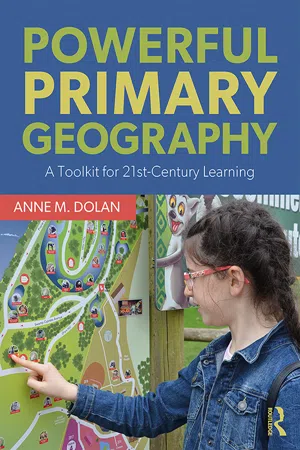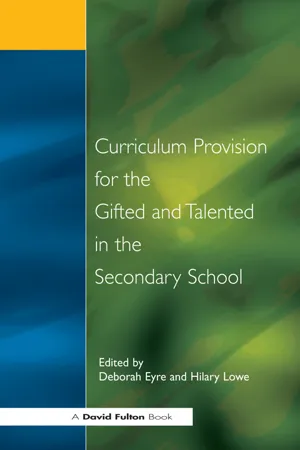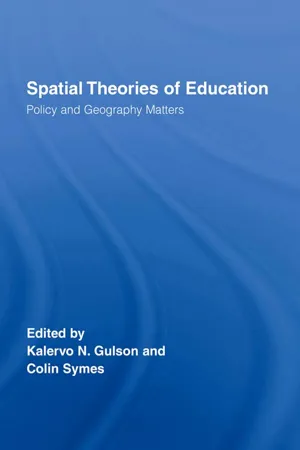Geography
Geographical Skills
Geographical skills refer to the abilities and techniques used to study, analyze, and interpret the Earth's features and phenomena. These skills include map reading, spatial analysis, data interpretation, and fieldwork. Geographers use these skills to understand the relationships between human societies and the natural environment, as well as to address complex geographical issues and challenges.
Written by Perlego with AI-assistance
7 Key excerpts on "Geographical Skills"
Learn about this page
Index pages curate the most relevant extracts from our library of academic textbooks. They’ve been created using an in-house natural language model (NLM), each adding context and meaning to key research topics.
- eBook - ePub
- Mark Harris(Author)
- 2017(Publication Date)
- Routledge(Publisher)
The skills we are trying to develop are not just useful for the geography classroom but should be the necessary skills for 21st century learners to excel at university, the work place and in general life. To begin with, consider which skills your students need to be successful in their exams. I have listed what I consider to be the necessary skills students need to possess in order to become competent geographers, and these can be developed through their years at the school.Geographical Skills that are required to create successful students include the following. Students should be able to:- Make decisions based on different sources of evidence
- Use specialist geographical vocabulary
- Read and use a variety of maps, plans and atlases
- Use Geographical Information Systems (GIS) with confidence
- Interpret photographs, diagrams, data, newspapers, journals and information from the Internet
- Accurately analyse and interpret data, graphs, tables and charts
- Link ideas and concepts together
- Write appropriately for a range of audiences
- Use a range of numeracy and graphicity skills including the production, interpretation and analysis of line, bar, scatter and triangulation graphs, pie charts, chloropleth, isoline and dot maps
- Present to peers and a range of audiences with confidence
- Communicate with others using a range of technologies
- Contribute to collaborative projects
- Talk, read and write like a geographer
- Use fieldwork to create and test hypotheses, collect and present data that can be analysed and interpreted to draw conclusions, evaluate their own process and offer further research opportunities
- A detailed and accurate knowledge of case studies to support a wide variety of geographical contexts
- A range of exam techniques that allows the students to access the exam question
- eBook - ePub
Powerful Primary Geography
A Toolkit for 21st-Century Learning
- Anne M. Dolan(Author)
- 2020(Publication Date)
- Routledge(Publisher)
Thinking geographically is not the same as everyday thinking. Geographical thinking involves making connections between local and global, human and physical, near and far, time and distance, and so on. Jackson (2006: 199) says ‘thinking geographically offers a uniquely powerful way of seeing the world and making connections between scales, from the global to the local’. Geographers make sense of the world by synthesising information from various sources through the use of Geographical Skills and concepts. Brooks et al. (2017) suggest that geographical education can provide powerful ways of thinking about contemporary and future issues. Simply knowing the capital of France or the location of the river Thames or being able to recite the states of America does not in itself constitute geographical thinking. Traditional rote-learning approaches do little to promote geographical thinking. Edelson et al. (2013: 10) advise against the teaching of geography as ‘a litany of locations’, arguing that the ‘where’ comprises the basic alphabet of geography, while the question ‘why there’ focuses on the connections between places and promotes sophisticated geographical thinking.Enquiry-based learning and geographical investigations which involve decision-making and/or problem-solving bring children through a process which generates geographical thinking. The Road Map for 21st Century Geography Education Project (Edelson et al., 2013: 10) argues that essential geographic practices for promoting geographical thinking are:- formulating geographic questions;
- acquiring, organising and analysing geographic information; and
- explaining and communicating geographic patterns and processes.
Advocates of holistic geography suggest that young people need to move beyond studying geographical topics in isolation (Reimers et al., 2016). Instead they need to think geographically by seeing the connections between different systems (Bonnett, 2012). However, some schools and textbooks employ a superficial approach to geography. Hence, there is an over-reliance on studying one topic at a time with no broader context. This exacerbates the public perception of geography as that of a ‘fact-based rather than conceptual discipline’, otherwise known as a ‘Trivial Pursuits’ version of geography (Jackson, 2006). - eBook - ePub
- Patrick Wiegand(Author)
- 2006(Publication Date)
- Routledge(Publisher)
By the end of this phase, students should begin to be able to evaluate maps and express their preferences in an informed way as a result of their own map making. They should be able to examine maps critically, taking into account the date and what may have taken place since the map was made. Evaluating map quality and assessing the degree to which a map meets stated needs is not a skill that has traditionally been taught but one which is increasingly important. The enormous numbers of maps that are available online makes it essential that school students are empowered to make an appropriate selection for a particular purpose (such as illustrating a project report, wayfinding or using the map as a source of evidence). A suitable activity might be to select five maps of the same place or on a similar theme from the internet and rank them for quality against a list of criteria.Learning to use GISystems
Reference was made in the last chapter to Local Studies as a simple digital mapping tool popular in primary schools. For secondary school, AEGIS 3 (see Appendix) is an educational GISystem constructed specifically for classroom use which assembles maps, data, text and multimedia boxes in the form of standard A4 sized interactive worksheets with which students can explore data, solve problems and then readily print. Learning is thus situated in the context of a familiar ‘page’ format although with standard GIS functionality (for example, vector maps can be drawn or imported at any scale and in a variety of formats and then edited and data displayed). Plate 11 shows a partly completed exemplar worksheet with which students are exploring changes in the economic geography of Italy.Whatever software is being used it is likely that early learning in GIS will need to be monitored against some key basic skills. These include being able to zoom in and out of the map area, pan in order to slide into view those parts of the map area ‘off screen’, add labels to features (and change the font size of labels), sort tables in ascending and descending order and select individual records from a table so that they can be identified on the map. Students should be able to make a map for a specified purpose by selecting and adding data, selecting the most appropriate symbology and displaying and printing the map together with the peripheral information a reader needs in order to be able to interpret it (e.g. a title, scale, legend, etc.). Other basic skills include understanding (for example) the operation of the Windows environment and how to save a project. Later, students will learn to operate wizards and drop down dialog boxes in order to fulfil particular display and analytical functions. This might include looking for spatial associations between datasets such as assessing the extent to which one phenomenon is found within a certain distance of another. In the case of the ArcView project in Figure 8.5 - Deborah Eyre, Hilary Lowe(Authors)
- 2013(Publication Date)
- David Fulton Publishers(Publisher)
GeographyDavid LeatGeography is a boundary crossing subject. The downside to this is that it has periods of identity crisis, when its advocates struggle to justify its contribution to the curriculum or education. The upside, however, is that it provides a wonderful range of learning experiences. It is not just that it is topical; it is very catholic, in that it draws upon information in many forms – text, image, moving image, symbols, graphics, spoken word, models, sound etc. Thus it can appeal to all the senses and use the spectrum of cognitive and emotional processes that help make sense of rich information.If geography teachers look in the ‘The National Curriculum – Handbook for secondary teachers in England’ (1999) (available at www.nc.uk.net ) they should be impressed and reassured by the ease with which the subject can address the values, aims and purposes of the National Curriculum. However this chapter will particularly highlight the contribution that geography can make to Key Skills and Thinking Skills. These strands offer tremendous opportunities for geography teachers to demonstrate how much the subject has to offer very able pupils and indeed all pupils.The National Curriculum Handbook provides a little more detail on Key Skills:- Working with others … includes the ability to contribute to small group and whole class discussion, and to work with others to meet a challenge … to appreciate the experience of others and consider different perspectives, and to benefit from what others think, say and do.
- Improving own learning and performance – involves pupils reflecting on and critically evaluating their work and what they have learnt, and identifying ways to improve their learning and performance. (They need to be able to identify the purposes of learning, to reflect on the processes of learning, to identify obstacles or problems in learning).
- John Bale(Author)
- 2013(Publication Date)
- Routledge(Publisher)
3 Teaching map skillsThere is little controversy surrounding the assertion that all primary school children should be introduced to map work and mapping skills. At the end of the primary phase children should be able to understand and apply ideas such as direction, location, scale and symbolism (Boardman, 1983). Although in the early years of primary education learning mapping skills will be rooted very firmly in the known, local environment, by the age of 11 children will have started making the transition to small-scale maps and from an atlas will be able to use the basic elements described above at continental and global scales.If the first basic tenet of geography teaching is to work from the known to the unknown, the second is that we begin geographical education with large-scale maps and from these proceed to those of smaller scale. Large-scale maps have greater detail and cover smaller areas than small-scale maps. A 1:2,500 Ordnance Survey plan is an example of a large-scale map; an atlas map of the world is a small-scale map. It is upon large-scale maps (Table 3.1 ) that we focus for most of this chapter.Table 3.1 Large-scale mapsRepresentative fractionArea coverageSpace coverage1:1250 Urban areas 500 m. sq. 1:2500 Britain but not mountain and moorland 2 km. sq. 1:10000 Whole of Britain 5 km. sq. A number of map elements (Catling, 1981) exist which will aid the teacher in the identification of what ought to be taught in primary school mapwork. These elements are:(a) Perspective – maps enable us to see what is hidden at ground level.(b) Position and orientation – maps show how features of various kinds are geographically related to one another and where they are located. From them directions can be given and grid systems added to aid the identification of accurate location.(c) Scale- Elisabete A. Silva, Patsy Healey, Neil Harris, Pieter Van den Broeck, Elisabete A. Silva, Patsy Healey, Neil Harris, Pieter Van den Broeck(Authors)
- 2014(Publication Date)
- Routledge(Publisher)
4.8 Geoprocessing and Spatial Planning Some concepts and applications Jorge Xavier da Silva, Tiago Badre Marino and Maria Hilde de Barros Goes DOI: 10.4324/9781315851884-36 Introduction The recent development of geotechnologies has brought many advances to environmental studies. Geoprocessing techniques have increasingly being used in rural and urban planning and management as an integrative procedure dealing directly and simultaneously with both the spatial and the taxonomic research dimensions. They contribute to the creation of reasonable theoretical and practical assemblages, not only of data but also of knowledge concerning environmental problems. Although centred in geoprocessing and in previous works developed by the authors, this chapter discusses concepts, methods and techniques applied to varied research fields which deal with spatial data generation and analysis, such as digital cartography, global positioning systems (GPS), remote sensing and, hopefully, spatial planning. This chapter begins by illustrating why there is a growing interest in environmental research in the “geo” procedures and problems (Xavier-da-Silva and Marino, 2010, 2011). In a second stage, we clarify several terms, such as geodiversity (Xavier-da-Silva et al., 2001, p. 304), an expression described as a representation of the variability of environmental characteristics; geotopology (Xavier-da-Silva and Zaidan, 2007, p. 20), which considers proximities and types of dispersion; and geoinclusion (Xavier-da-Silva and Marino, 2011), which may refer, for example, to the insertion of data about the population and its activities into their geographical – physical, biotic and socio-economic – context- eBook - ePub
Spatial Theories of Education
Policy and Geography Matters
- Kalervo N. Gulson, Colin Symes(Authors)
- 2007(Publication Date)
- Routledge(Publisher)
5 Geographical information systems (GIS) and school choice The use of spatial research tools in studying educational policy Chris TaylorGeographies of education are not new. One of the earliest attempts to highlight the spatial imbalance in education provision across the UK was by Henry Brougham during the 1820s, using a series of national surveys. Furthermore, as Bradford (1990) has outlined, it is not difficult to see the role a geography of education can have in understanding society (e.g. through housing markets), the economy (e.g. through labour markets), and polity (e.g. through political power). There have been numerous social studies during the last few decades where space and place have played an important part in understanding social inequalities and the inadequacy of policy in addressing these, particularly in relation to the notion of ‘community’ and ‘neighbourhood’. For example, in their study of working class children Jackson and Marsden (1966) place the community of Huddersfield in the UK at the centre of their analysis and understanding of the impact of education. Yet it is still the case that the geography of education is a relatively under-developed area of research (Bradford 1990; Taylor 2002). This is beginning to change, and this book is testament to that. To a large extent work in this area has been primarily interested in more contemporary sociological theories of space of, say, David Harvey and Doreen Massey. But there is much also to be gained by considering more traditional theories of space, such as accessibility, location, and mobility. It is also the case that there have been significant technological innovations in geographical analyses through the use of Geographical Information Systems (GIS) that are entirely appropriate in their application to the field of education. This chapter endeavours to illustrate how more traditional theories of space, alongside some of the more contemporary spatial theories, can aid our understanding of school choice and the impact of increased marketization in publicly-funded education provision. It also provides an illustration of the use of GIS in this area and in particular the use of postcode data analysis that is now commonplace throughout marketing research and ‘quantitative’ geography.






